The 1960s: Incredible Growth Amid Chaos
The 1960s were years that saw the fabric of post World War II society come unwound. Yet, at the turn of the decade, before the chaotic times began, the US coasted on the serenity of the Eisenhower era, and was strapping in for the excitement of the Kennedy years. These were prosperous days which bode well for HVACR contractors and the industry.
In 1961, the air conditioning and refrigeration industry had its best year to date, in terms of unitary equipment sales -- most of which went into the exploding residential new construction market. Yet, based on a survey conducted by the editors of The Refrigeration and Air Conditioning Business, most residential salesmen didn't have air conditioning in their own homes! Their credibility, as well as that of the industry, was at stake.
Service was in the background. Who needed to do service with over 240,000 new homes being built and more being forecasted for the future?
Foreign issues also added to the potential growth of our market. With the Bay of Pigs and Cuban Missile Crises, President John F. Kennedy bid Congress for $700 million to build community fallout shelters, and a good chunk of it was earmarked for the HVAC systems necessary for those shelters.
It was also in these early days that the predecessor of the Air Conditioning Contractors of America, the National Warm Air and Air Conditioning Association, offered a simplified method for calculating heat loss and gain in their Manual 3 and Manual 11.
During the 4th annual meeting of the Better Heating Council, President Marvin Mitchell announced the first united marketing effort between the warm air, electric, and the hydronic industries.
On a different front, contractors were battling against five-year warranty programs newly introduced by many equipment manufacturers.
Sound familiar? Many issues that burned in the heart of this industry still do today. Items like how to handle replacement sales, how to level out the ups and downs of a seasonal business, and where to find good technicians filled the headlines of this publication.
Product rating systems came into being during the early 1960s when ARI established its equipment certification program.
The mid 1960s showed the HVAC industry enjoying spectacular growth. The market for air condi¬tioning was surpassing that of refrigeration, so the magazine changed its name to The Air Conditioning and Refrigeration Business.
Commercial applications grew in size and complexity and computerized control systems began to appear in the market. Large and clumsy, they still provided excellent control accuracy.
As applications grew more complex, the role of the contractor became more central to the specification of equipment and parts.
Then, in August, 1965, the phrase, "Total Comfort System" was coined -- first by Westinghouse, then by Lennox.
Lennox President John Norris, Sr. defined the total comfort system as one that achieves "the perfect indoor climate without a single compromise."
While the 1960s began quietly, they ended in a surreal montage of violence and achievement. In 1968 and 1969, we witnessed the murders of Robert Kennedy and Martin Luther King, and the glory of human beings walking on the moon for the first time.
The industry introduced many technologies -- from district heating and computerization to gas driven air cooling, variable air volume systems, computer room cooling, and automated dispatching and inventory systems for contractors.
Decreasing kilowatt costs led to increased demand for all electric comfort systems. Commercial air conditioning was also on the rise and negotiated contracts were starting to appear. Then the proverbial "stuff" hit the fan. During 1969, Congress was considering a bill to regulate the HVAC industry. Complaints of shoddy workmanship and questionable sales techniques were filed nationwide, based on the massive failures of air conditioning systems during a sweltering heat wave that swept the country in 1968.
To add to our expanding black eye, there was a serious shortage of service technicians needed to fix these ailing systems. Still, the residential construction market continued to grow.
At the close of business in December, 1969, our industry and our country stood on the brink. Faced with these problems, the unrest, and clouds gathering on the international horizon, this industry was poised to either evolve to a higher level, or succumb to the mediocrity of federal regulation.
Read other Contracting Business decades
